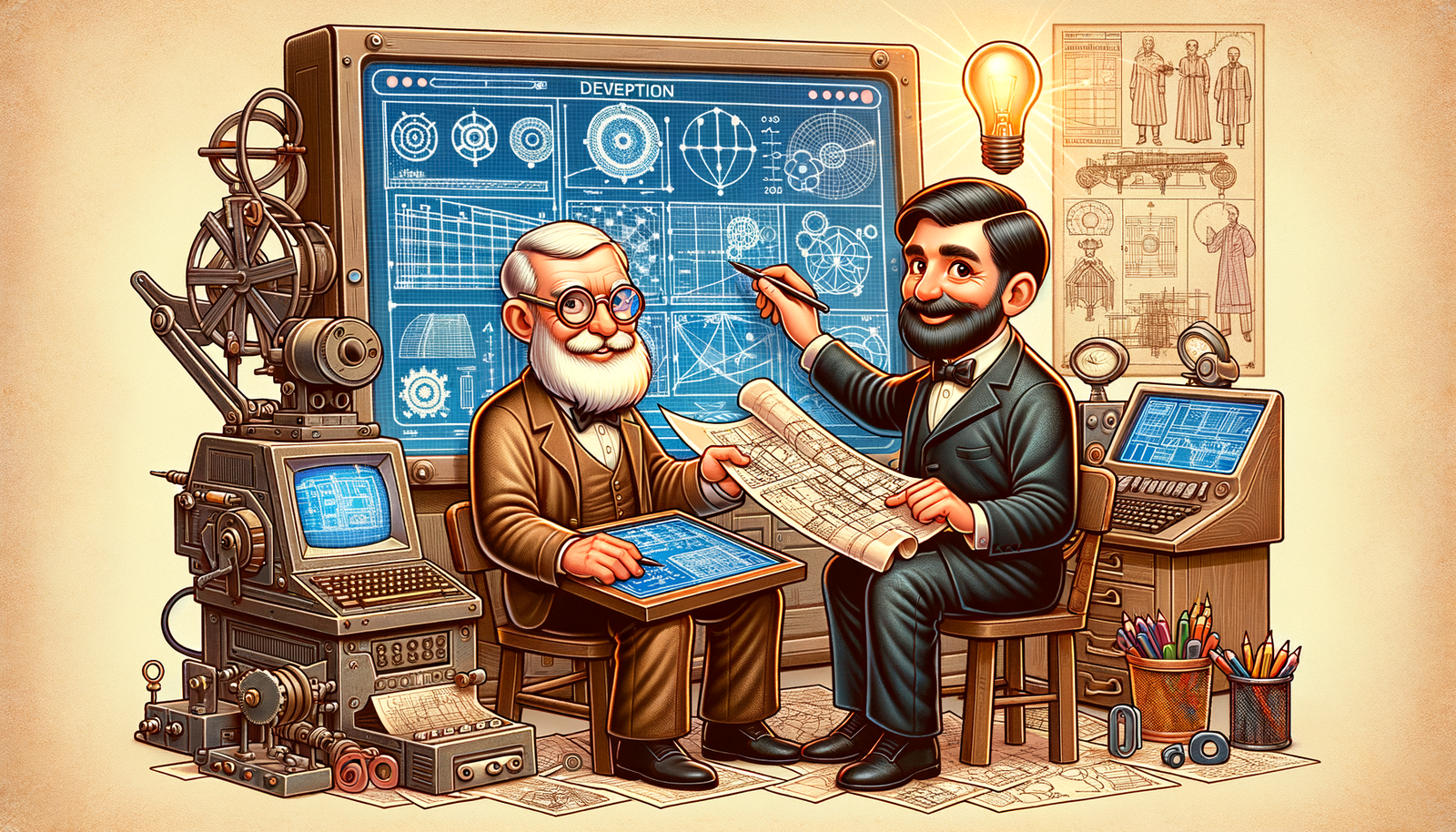Your Cart is Empty
Customer Testimonials
-
"Great customer service. The folks at Novedge were super helpful in navigating a somewhat complicated order including software upgrades and serial numbers in various stages of inactivity. They were friendly and helpful throughout the process.."
Ruben Ruckmark
"Quick & very helpful. We have been using Novedge for years and are very happy with their quick service when we need to make a purchase and excellent support resolving any issues."
Will Woodson
"Scott is the best. He reminds me about subscriptions dates, guides me in the correct direction for updates. He always responds promptly to me. He is literally the reason I continue to work with Novedge and will do so in the future."
Edward Mchugh
"Calvin Lok is “the man”. After my purchase of Sketchup 2021, he called me and provided step-by-step instructions to ease me through difficulties I was having with the setup of my new software."
Mike Borzage
Design Software History: Pioneers of CAD: Ivan Sutherland and the Revolutionary Sketchpad
July 18, 2024 4 min read


Introduction to Early CAD Concepts
In the pre-CAD era, designers relied heavily on traditional drafting techniques and tools to translate their ideas into tangible formats. This manual process entailed using instruments like compasses, protractors, and rulers to create precise and detailed drawings on paper or vellum. While these methods were effective for their time, they were wrought with limitations and challenges that hindered efficiency and accuracy.
The constraints of manual design included the inability to easily modify designs without starting over, difficulties in achieving precision, and significant time consumption. These challenges often led to errors and inconsistencies, demanding a more automated approach to design and engineering processes.
The initial steps towards automation began with the early visionaries who foresaw the potential of computers in aiding design. During the 1950s and early 1960s, the technological landscape was burgeoning with advancements in computing. Despite the rudimentary nature of computers at that time, the foundational concepts for computer-aided design (CAD) began to take shape, setting the stage for future innovations.
Ivan Sutherland and the Birth of Sketchpad
Ivan Sutherland: The Visionary
Ivan Sutherland, a pioneering figure in the field of computer graphics, was born in 1938. His profound interest in computers and graphics led him to pursue a stellar academic career. Sutherland completed his undergraduate studies at the Carnegie Institute of Technology and earned his Ph.D. from the Massachusetts Institute of Technology (MIT), where he was heavily influenced by his mentor, Claude Shannon.
Development of Sketchpad
The motivation behind creating Sketchpad stemmed from Sutherland’s desire to revolutionize the way designers interacted with computers. In 1963, as part of his doctoral thesis at MIT, Sutherland developed Sketchpad, a groundbreaking system that introduced a new paradigm in graphical interaction. Sketchpad showcased several key features and innovations such as the use of a graphical user interface (GUI), constraints, and object-oriented principles, which were revolutionary at the time.
Developing Sketchpad was not without its challenges. Sutherland had to overcome significant technical obstacles related to hardware limitations and computational power. However, his ingenuity and persistence led to the successful creation of a functional and interactive graphical system that captivated the academic and engineering communities.
The Impact of Sketchpad
The immediate reaction to Sketchpad was one of awe and admiration. The system was recognized for its originality and potential to transform design processes. Ivan Sutherland received numerous accolades for his work, including the prestigious Turing Award, cementing his legacy as a visionary in computer graphics and CAD.
Sketchpad’s Technological Innovations
Graphical User Interface (GUI)
One of the most significant contributions of Sketchpad was the introduction of the graphical user interface (GUI). Unlike the text-based interfaces prevalent at the time, Sketchpad allowed users to interact with the computer through graphical elements. This innovation was pivotal in making computers more accessible and intuitive for designers and engineers.
Sketchpad’s GUI laid the foundation for future CAD systems and influenced the development of modern graphical interfaces that we use today. The ease of manipulation and direct interaction with graphical data made Sketchpad a precursor to the sophisticated interfaces found in contemporary design software.
Object-Oriented Programming and Constraints
Sketchpad was also notable for its use of constraints in design. Constraints allowed designers to define relationships between different elements of a drawing, ensuring consistency and accuracy. This feature was instrumental in simplifying complex designs and maintaining geometric integrity.
Furthermore, Sketchpad’s approach to managing graphical objects can be seen as an early implementation of object-oriented programming principles. Each graphical element in Sketchpad was treated as an object with its own properties and behaviors, a concept that has become fundamental in modern software development.
Interactive Graphics
Another groundbreaking aspect of Sketchpad was its support for real-time interaction with graphical data. Prior to Sketchpad, most computer programs operated in batch processing mode, where users would input data and wait for the computer to process it before receiving the output. Sketchpad enabled users to see the results of their actions immediately, fostering a more dynamic and interactive design process.
This shift towards interactive graphics was crucial in the evolution of CAD systems, as it allowed designers to experiment and iterate on their ideas more fluidly and efficiently.
Legacy and Influence on Modern CAD Systems
Influence on Subsequent CAD Software
Sketchpad set the stage for future CAD software developments by introducing concepts and technologies that became the backbone of modern design tools. Many of the core principles pioneered by Sketchpad, such as the GUI, constraints, and object-oriented programming, have been integrated into various CAD systems used today.
- AutoCAD
- SolidWorks
- CATIA
- Pro/ENGINEER
These and other contemporary CAD systems owe a great deal to the innovations introduced by Sketchpad, which transformed the landscape of computer-aided design.
Ivan Sutherland’s Continued Contributions
Following the success of Sketchpad, Ivan Sutherland continued to make significant contributions to the field of computing. He co-founded Evans & Sutherland, a company that specialized in computer graphics hardware and software. Sutherland also held various academic positions, inspiring countless students and researchers in computer science and engineering.
Current Relevance of Sketchpad’s Innovations
The concepts introduced by Sketchpad remain highly relevant in today’s CAD applications. The use of GUIs, constraints, and object-oriented principles continue to be fundamental in modern design software. Moreover, the emphasis on interactive graphics has only grown with advancements in computational power and user interface design.
As CAD systems continue to evolve, the pioneering work of Ivan Sutherland and Sketchpad serves as a lasting inspiration, driving innovation and shaping the future of design technology.
Conclusion
Summary of Sketchpad's Historical Significance
In summary, Sketchpad’s groundbreaking role in CAD history cannot be overstated. It introduced key innovations that have had a profound and lasting impact on the field of computer-aided design. Ivan Sutherland’s visionary work not only transformed design processes but also laid the groundwork for future advancements in technology.
Reflection on the Future of CAD
As we look towards the future of CAD, the pioneering work of Ivan Sutherland continues to inspire new generations of designers and engineers. The prospects for future advancements in CAD technology are vast, with ongoing developments in artificial intelligence, virtual reality, and collaborative design tools. By building on the foundational concepts introduced by Sketchpad, the future of CAD holds immense potential for innovation and creativity.
Also in Design News

Cinema 4D Tip: Enhancing Volumetric Effects in Cinema 4D with PyroCluster Techniques
October 28, 2025 3 min read
Read More
Bluebeam Tip: Enhance PDF Navigation and Management with Bluebeam Revu's Thumbnails Panel
October 28, 2025 2 min read
Read MoreSubscribe
Sign up to get the latest on sales, new releases and more …



